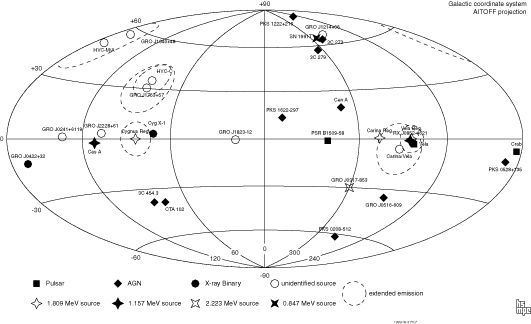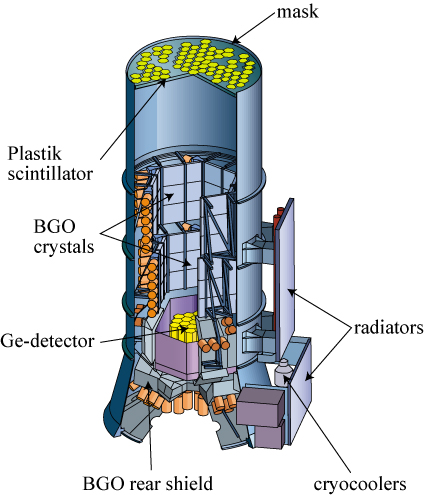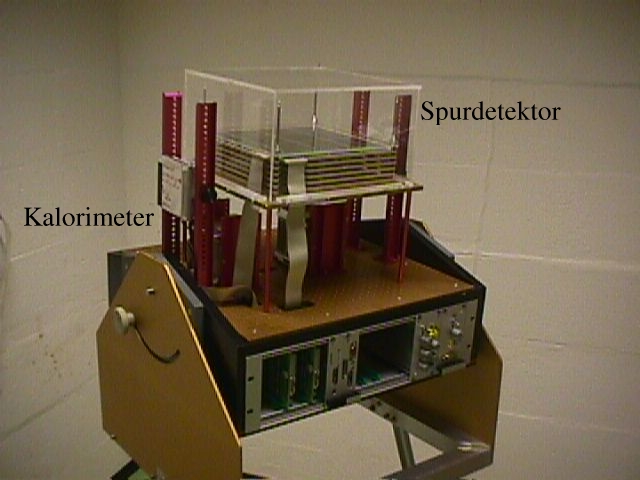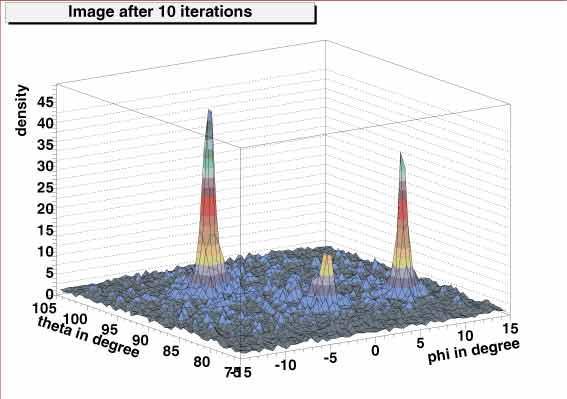|
4. Gamma-Astronomie |
4. Gamma-Ray Astronomy |
|
Das Compton Gammastrahlen-Observatorium CGRO der NASA ist weiterhin in Betrieb und wird dies mindestens für drei weitere Jahre bleiben. COMPTEL liefert nach wie vor Daten von hoher Qualität. Sie stellen die Basis für die meisten astrophysikalischen Auswerte- und Interpretationsaktivitäten in der Gamma-Gruppe dar. Für EGRET ist die Mission praktisch zu Ende, da das Funkenkammergas im wesentlichen verbraucht ist. EGRET wird in Zukunft nur noch bei einigen wenigen, außergewöhnlichen Ereignissen eingeschaltet werden können und kann dann auch nur in einem reduzierten Modus betrieben werden. Die rein elektronischen Detektoren von EGRET (z.B. Kalorimeter und Antikoinzidenz) sind in sehr gutem Zustand und liefern Daten zu Gammabursts und anderen transienten Ereignissen.
|
NASA's Compton g
-Ray Observatory CGRO is still in operation and will remain so for at least three more years. COMPTEL continues to provide high-quality data. These data are the basis for most of the analysis and interpretation activities in the gamma-ray group. For EGRET the mission is practically finished, since the spark-chamber gas is nearly exhausted. In future EGRET will only be switched on for a few exceptional events, and will then operate in a reduced mode. The purely electronic detectors of EGRET (i.e. calorimeter and anticoincidence) are functioning well and produce data for gamma-burst events and other transients.
|
 |
|
Abb. III-11: Himmelskarte des COMPTEL-Quellkataloges.
Fig III-11: All-sky view of the COMPTEL source catalogue.
|
|
Eine der Hauptaufgaben von COMPTEL war es, erstmals eine vollständige Himmelsdurchmusterung im MeV-Bereich durchzuführen. Dieses Ziel ist erreicht worden. Es liegen jetzt Himmelskarten der Kontinuums-emission im Bereich 1-30 MeV und in der 1,809 MeV 26Al-Linie vor (Abb. II-19). Aus diesen Karten wurde im Berichtsjahr erstmals ein COMPTEL-Katalog erstellt, der 32 Quellen enthält. Bei den Quellen mit Kontinu-umsemission handelt es sich um Pulsare, Kandidaten für stellare schwarze Löcher, Supernovaüberreste, interstellare Wolken und Kerne aktiver Galaxien. Quellen mit Gammalinien-Emission wurden im Lichte der 1,809 MeV 26Al-Linie, der 1,157 MeV 44Ti-Linie, der 0,847 MeV und 1,238 MeV 56Co-Linien und der Neutronen-Einfangslinie bei 2,223 MeV nachgewiesen. Abb. III-11 stellt eine Himmelskarte des Quellkatalogs dar. Sechs der aufgeführten Quellen sind ausgedehnt. Möglicherweise kommt die Ausdehnung dadurch zustande, daß man an diesen Stellen die Summe mehrerer unaufgelöster Punktquellen sieht. Mit dieser Himmelsdurchmusterung hat COMPTEL erstmals das MeV-Fenster für die Astronomie geöffnet.
|
One of the main goals of COMPTEL was the first complete mapping of the sky in the MeV range. This has been achieved. Full-sky maps of continuum emission for 1-30 MeV and in the 1.809 MeV 26Al-line are available (Fig II-19). A COMPTEL source catalogue based on these maps was produced this year for the first time. It contains 32 sources. The objects with continuum emission are pulsars, stellar black-hole candidates, supernova remnants, interstellar clouds and active galactic nuclei. Sources with gamma-ray line emission were detected in the 1.809 26Al-line, the 1.157 44Ti-line, the 0.847 MeV and 1.238 MeV 56Co-lines and the neutron-capture line at 2.223 MeV. Fig. III-11 shows a skymap of the source catalogue. Six of the plotted sources are extended; possibly the extension is due to the fact that in these directions the sum of several unresolved sources is seen. With this sky-survey, COMPTEL has opened the MeV-window for astronomy for the first time. |
|
INTEGRAL wird in den nächsten Jahren das wichtigste Projekt der Gammagruppe des MPE sein. INTEGRAL ist eine ESA-Mission, die die erfolgreichen Messungen von COS-B und CGRO fortsetzen soll. Aufgabe von INTEGRAL soll es sein, Gammaquellen am Himmel genau zu lokalisieren und deren Emissionsspektren mit hoher Auflösung zu vermessen. Dieses Ziel soll mit zwei Instrumenten (dem Imager IBIS und dem Spektrometer SPI) erreicht werden. IBIS soll mittels einer kodierten Maske Punktquellen am Himmel genau lokalisieren, während SPI hochauflösende Gammalinienspektroskopie im Energiebereich von 20 keV – 8 MeV betreiben soll. Dafür besitzt SPI 19 hexagonale Ge-Kristalle, die mit Hilfe eines elektrischen Kühlsystems auf etwa 85 K abgekühlt werden. Zur Hintergrundunterdrückung ist der Ge-Detektor mit Ausnahme des Gesichtsfeldes, in dem sich eine passive kodierte Maske befindet, von einer massiven BGO-Abschirmung umgeben, die in Antikoinzidenz zum Detektor geschaltet ist. Eine schematische Darstellung von SPI wird in Abb. III-12 gezeigt.
|
In the coming years INTEGRAL will be the most important project of the gamma-ray group of MPE. INTEGRAL is the next medium-sized gamma mission of ESA which should continue the successful measurements of COS-B and CGRO. The task of INTEGRAL is to localize gamma-ray sources on the sky with high precision and to measure their energy spectra with high resolution. This goal is achieved with two instruments, the imager IBIS and the spectrometer SPI. IBIS is designed to localize point sources on the sky precisely with a coded mask, while SPI will perform high-resolution gamma-ray line spectroscopy in the energy range 20 keV – 8 MeV. The spectrometer SPI consists of 19 hexagonal Ge-crystals which are cooled to about 85 K by means of an electrical cooling system. For background suppression the Ge-detector is surrounded by a massive anticoincidence BGO shield leaving only the field of view open, which is covered by a passive-coded mask. A schematic drawing of SPI is shown in Fig. III-12. |
 |
Abb. III-12: Eine schematische Darstellung des INTEGRAL-Spektrometers SPI.
Fig. III-12: A schematic drawing of the INTEGRAL- spectrometer SPI. |
|
Die unter der Verantwortung des Instituts erfolgte Entwicklung des Antikoinzidenzsystems für SPI wurde zu Beginn des Jahres mit dem erfolgreichen Test der Elektronik abgeschlossen, so daß mit dem Bau der Flughardware begonnen werden konnte. Während die mechanische Fertigung problemlos voranging, traten bei der elektronischen Fertigung unerwartet Probleme mit den Photomultipliern und Keramikleiterplatten der Hochspannungsteiler auf. Trotz des dadurch entstandenen Zeitverzugs soll das INTEGRAL-Teleskop im Herbst 2001 mit einer russischen Trägerrakete vom Weltraumbahnhof Baikonur in Kasachstan in eine Erdumlaufbahn gebracht werden und ab Frühjahr 2002 Wissenschaftlern aus aller Welt für Beobachtungen zur Verfügung stehen.
|
The development of the anticoincidence subsystem for the INTEGRAL-spectrometer SPI, for which the institute is responsible, was completed at the beginning of the year with the successful test of the electronics, so that the production of the flight hardware could be started. While the mechanical fabrication was completed without difficulty, unexpected problems arose with the photomultipliers and the ceramic boards of their voltage dividers. In spite of the time delay caused by these problems INTEGRAL is still to be launched in autumn 2001 with a Russian Proton rocket from Baikonur in Kasachstan. In the spring of 2002 it will be at the disposal of scientists from all over the world for observations. |
|
Das elektronische Konzept der Antikoinzidenz wurde so erweitert, daß es in der Lage ist, die Ankunftszeit von Gammasbursts mit hoher Sensitivität bis auf 50 ms genau zu messen. INTEGRAL wird damit als Teil des 4. Interplanetaren Netzwerks dazu beitragen, daß etwa 100-200 Bursts pro Jahr durch Triangulation bis auf einige Bogensekunden genau lokalisiert werden können.
|
The electronic layout of the anticoincidence was extended so that it is now possible to measure the arrival time of gamma-ray bursts with a high accuracy of 50 ms. INTEGRAL will therefore be able to determine within the 4th interplanetary network the position of gamma-ray bursts via triangulation. Estimates have shown that with the anticoincidence subsystem of SPI about 100-200 bursts per year can be measured whose position can be determined down to the arcsecond range.
|
|
Das INTEGRAL-Datenzentrum (ISDC) wird in Versoix in der Nähe von Genf aufgebaut. Dort sollen die Flugdaten aller vier Instrumente prozessiert, archiviert und an die beteiligten Wissenschaftler verteilt werden. In Versoix wird auch eine "quick-look"-Analyse veränderlicher Quellen durchgeführt und die endgültigen Daten-Produkte erzeugt. Der direkte "on-line"-Zugriff auf die Daten und die Auswertesoftware, aber auch ein transportables Auswertesystem für die Institute der Instrumentatoren und Gastbeobachter wird zur Verfügung gestellt.
|
A data centre for the INTEGRAL Mission has been established at Versoix near Geneva. This INTEGRAL Science Data Centre (ISDC) will be responsible for the processing, archiving and distribution of data from all four INTEGRAL instruments to the scientific community. At Versoix a quick-look analysis for transients will also be performed and the final data products will be generated. ISDC will provide on-line access to the database and analysis software, and will also provide a portable system for INTEGRAL data analysis at team and guest investigator institutes. |
|
Unser Institut ist direkt am Aufbau des ISDCs beteiligt und liefert Beiträge zur Überwachung und Kalibrierung des SPI-Instruments während der Mission. Für das Spektrometer SPI entwickelt unser Institut die Software für die Erstellung großräumiger Himmelskarten. Außerdem wird am MPE die Vorbereitung der wissenschaftlichen Auswertemethoden im Rahmen der INTEGRAL-Datenanalyse-Gruppe koordiniert.
|
Our institute is directly involved in the development of the ISDC and provides specific software for the monitoring and calibration of the SPI instrument. We are also responsible for SPI imaging software focussing on large-scale surveys and diffuse emission. The overall coordination of the SPI software development is also part of the MPE responsibility. |
|
Die Gamma-Gruppe hat im Berichtsjahr Vorschläge für eine zweifache Beteiligung am GLAST-Projekt (Gamma-Ray Large Area Space Telescope) eingereicht.
|
The gamma-ray group has submitted proposals for a twofold participation in the GLAST project (Gamma-Ray Large-Area Space Telescope). |
|
GLAST wird voraussichtlich das einzige Hochenergie-Gamma-Teleskop im Zeitraum 2005 bis 2015 sein. Es wird voraussichtlich überwiegend in einem Zenith-gerichteten Scanning-Modus betrieben. Dank seines großen Gesichtsfeldes wird so innerhalb eines Erdumlaufs der gesamte Himmel beobachtet. Dies erlaubt insbesondere die Beobachtung sämtlicher Flares von Aktiven Galaktischen Kernen und anderen zeitvariablen Quellen. GLAST bietet so auch eine Pfadfinderfunktion für alle Instrumente mit kleinem Gesichtsfeld. Die Zahl der beobachteten Gamma-Quellen wird sich durch GLAST von ~300 (EGRET) auf 6000 bis 30000 erhöhen. Der geplante Beitrag unseres Instituts am Hauptteleskop wird bei der Entwicklung von Software und der Unterstützung der Kalibrierung liegen.
|
GLAST is expected to be the only high-energy gamma-ray telescope during the period from 2005 to 2015. It is planned to be operated in a zenith-pointing scanning mode. Thanks to its extremely large field of view the whole sky will be observed during a single orbit. This continuous observation of the whole sky allows the detection of all flaring active galactic nuclei and other transients. GLAST will thus also serve as a pathfinder for all telescopes with narrow field of view, be they ground-based or in orbit. The number of observed gamma-ray sources will increase with GLAST from ~300 (EGRET) to between 6000 and 30000. Our institute’s contribution to the main instrument will be software development and support for the calibration. |
|
Zusammen mit der Gammaburst-Gruppe vom Marshall Space-Flight Center und der Universität von Alabama in Huntsville hat die Gammagruppe des MPE darüberhinaus einen Burstmonitor als sekundäres Instrument für GLAST vorgeschlagen. Damit sollen gut aufgelöste Spektren von Gammabursts im Energiebereich 5 keV – 30 MeV gemessen werden, um die hochenergetischen Messungen von Gammabursts durch das Hauptinstrument zu ergänzen und zu niedrigen Energien hin zu erweitern.
|
In addition, the gamma-ray group of MPE in collaboration with the gamma-ray group of the Marshall Space-Flight Center and the University of Alabama in Huntsville has proposed a gamma-ray burst monitor for GLAST as a secondary instrument. The aim of this monitor is to measure with good resolution spectra of gamma-ray bursts in the energy range 5 keV – 30 MeV, to support the high-energy measurements of gamma-ray bursts with the main instrument and to extend these to lower energies. |
|
Im Mittelpunkt der Neuentwicklungen von Instrumenten im Gammabereich steht der Prototyp eines Teleskops für die "Mittel-Energie Gamma-Astronomie" (MEGA) im Energiebereich von 0,5 bis 50 MeV. Diese g
-Kamera nutzt die modernste Detektortechnologie und integrierte Elektronik, um ein Meßgerät mit einer Sensitivität zu realisieren, das bisherige Systeme um ca. eine Größenordnung übertrifft. Im angestrebten Energiebereich werden Gamma-Quanten durch Comptonstreuung und Paarerzeugungsereignisse nachgewiesen. MEGA kann beide Arten von Wechselwirkungen vollständig aufzeichnen und für die Abbildung in einem weiten Gesichtsfeld nutzen.
|
The focus of our efforts to develop an advanced telescope for "Medium Energy Gamma-Ray Astronomy" in the range of 0.5 – 50 MeV is the prototype g
-ray camera MEGA. This telescope is based on modern detector technologies and integrated electronics in order to realise an instrument that will surpass the sensitivity of previous systems by an order of magnitude. In the chosen energy range g
-ray photons interact via the Compton process and the pair-creation process. The MEGA telescope can fully measure both types of interactions and utilise them to image radiation from a large field of view. |
|
Im Falle einer Compton-Wechselwirkung wird das Rückstoßelektron in einem Stapel von Silizium-Streifendetektoren (Spurdetektor) abgebildet, im Falle einer Paarerzeugung das e+e--Paar. Die Absorption des gestreuten Quants, bzw. des e+e--Paares, wird in einem CsI-Szintillator dreidimensional aufgezeichnet (Kalorimeter). Der komplette Satz an Meßgrößen für jedes registrierte Ereignis ermöglicht eine direkte Rekonstruktion der Parameter des einfallenden Gammaquants (Richtung, Energie und eventuell Polarisation).
|
In the case of a primary Compton interaction the recoil electron is imaged in a stack of silicon-strip detectors. The e+e--pair in the case of a pair-creation event is also tracked. The absorption of the scattered photon or the e+e--pair is recorded in a CsI scintillator array with resolution in three dimensions. The full set of measurements for each photon will allow a direct reconstruction of the parameters of the incident photon (direction, energy and eventually polarisation). |
 |
 |
|
Abb. III-13: Prototyp der MEGA-Kamera im Labor (teilweise mit Detektoren bestückt)
Fig. III-13: Prototype of the MEGA camera in the laboratory, partly equipped with detector modules. |
Abb. III-14: Bild von drei Punktquellen (2 MeV), eingebettet in homogenen Hintergrund (Simulation).
Fig. III-14: Image of three point sources (2 MeV) embedded in a homogeneous background (simulation)
|
|
In Abb. III-13 ist der teilweise Aufbau des MEGA Prototypen im Labor zu sehen. Neben der technischen Entwicklung werden auch umfangreiche Simulationen zur Optimierung des Meßgeräts durchgeführt. Aus einer solchen Simulation wurde das Bild (Abb. III-14) berechnet, bei dem drei unterschiedlich starke 2 MeV Punktquellen vor einem homogenen Hintergrund angenommen wurden. Die Quellen heben sich deutlich ab und sind klar aufgelöst.
|
A partial montage of the MEGA prototype in the lab is shown in Fig. III-13. Parallel to the technical developments comprehensive simulations for the optimisation of the detector are carried out. Fig. III-14 shows the resulting image for a simulation of three point sources of different intensity at 2 MeV embedded in a homogeneous background. The sources are clearly resolved. |
|
Wir haben unter dem Namen OPTIMA (Optical Pulsar Timing Analyser) ein neues optisches Hochgeschwindigkeitsphotometer entwickelt, um Messungen an Pulsaren und anderen schnell variablen optischen Quellen durchzuführen. Der Vergleich und die Korrelation der optischen Emissionen mit den thermischen und nichtthermischen Strahlungen in anderen Spektralbändern trägt zur Differenzierung der Strahlungsprozesse in diesen Quellen entscheidend bei. OPTIMA verwendet hochsensitive Avalanche-Photodioden, um einzelne Photonen mit hoher Zeitauflösung und Quanteneffizienz nachzuweisen und aufzuzeichnen. Dadurch ist es möglich, Messungen über lange, auch nicht zusammenhängende Zeiträume zusammenzufassen, um schwache periodische Signale in Gegenwart eines starken Himmelshintergrunds nachzuweisen. Gleichzeitig kann man Messungen auch mit Daten von anderen Teleskopen und Satelliten synchronisieren. Der schrittweise Aufbau des Detektorsystems ist inzwischen weitgehend abgeschlossen, und es wurden 1999 mehrere Meßkampagnen durchgeführt. Im Januar wurde während einer Messung am 3,5 m Teleskop auf dem Calar Alto, die weitgehend durch schlechtes Wetter beeinträchtigt war, die Lichtkurve des Crab Pulsars gemessen und die technische Funktion von OPTIMA verifiziert. Im Juni 1999 wurden zeitgleich mit dem Rossi X-Ray Timing Explorer Satelliten optische und Röntgenmessungen am Binärsystem GX339-4 durchgeführt, in dem ein schwarzes Loch vermutet wird. GX339-4 befand sich leider im "Röntgen-Aus"-Zustand; als optische Quelle konnte das System jedoch klar nachgewiesen werden. Weiterhin wurden hochaufgelöste Messungen von Bedeckungen des kataklysmischen Variablen HU Aqr durchgeführt, die zur Bestimmung der Lage von Akkretionsströmen in diesem, von einem hochmagnetischen weißen Zwerg dominierten System dienen.
|
For the observation of optical emission from pulsars and other highly variable optical sources we have developed a new high-speed photometer called OPTIMA (Optical Pulsar Timing Analyser). The comparison and correlation of optical emission with the thermal and non-thermal radiation in other spectral bands allows us to differentiate and clarify the emission processes in these sources. OPTIMA uses highly sensitive avalanche photodiodes to detect single optical photons with high timing accuracy and quantum efficiency. It is thus possible to combine multiple observations over extended and non-consecutive timespans to reveal weak periodic signals in the presence of strong sky-background. Furthermore one can synchronise the OPTIMA measurements with data obtained from other telescopes and satellites. The stepwise construction of the detector system is nearly finished, and we carried out several observational campaigns in 1999. In January the technical functionality of OPTIMA was verified through the detection of the optical light curve of the Crab pulsar during a campaign at the 3.5 m telescope at the Calar Alto observatory (Spain). Most of this campaign was affected by bad weather. In June we observed, simultaneously with the Rossi X-ray Timing Explorer in the X-ray range, the black-hole candidate GX339-4 for correlated emissions. Unfortunately GX339-4 was in an unusual X-ray off-state. The optical source in this system could, however, be clearly detected. Further observations were directed at the cataclysmic variable HU Aqr. Eclipses in this binary system were recorded with high time resolution and will be used to determine the location of accretion streams in this system, which is dominated by a highly magnetized white dwarf.
|
|
Die GRO-Projekte COMPTEL und EGRET werden durch Mittel der DARA/DLR gefördert unter 50.QV.90968 und 50.QV.90955. INTEGRAL wird von der DLR unter 50.OG.9503.0 gefördert und MEGA unter 50.TT.97389. Wir wurden aus Mitteln der Verbundforschung unterstützt (50.OR.9701.4).
|
The GRO projects COMPTEL and EGRET are supported by DARA/DLR under 50.QV.90968 and 50.QV.90955. INTEGRAL is supported by DLR under 50.OG.9503.0 and MEGA under 50.TT.97389. We have received support from the Verbundforschung (50.OR.
9701.4).
|



